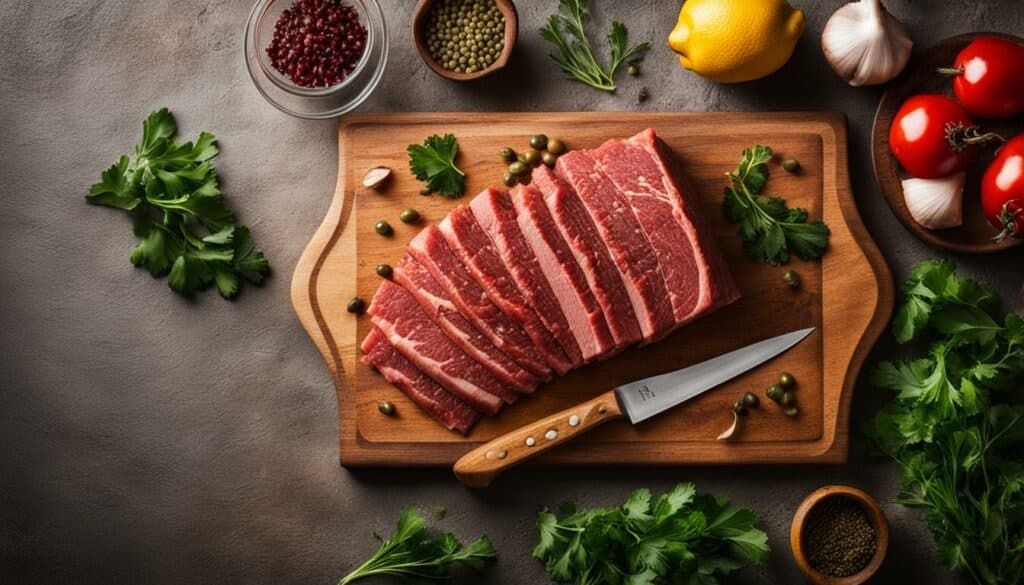Welcome to the tempting world of gourmet cuisine, where the unexpected flavors of raw beef tantalize the taste buds! If you’ve never tried beef tartare, you’re in for a treat. This extraordinary dish offers a unique culinary experience that combines simplicity with sophistication.
From its origins in the 19th century as a French delicacy, beef tartare has become a sought-after dish around the world. Its raw delight and distinct taste make it a favorite among adventurous food lovers and high-end dining establishments.
In this article, we’ll take you on a journey to discover all there is to know about beef tartare. From its definition and characteristics to recipes and serving tips, we’ll guide you through this deliciously raw experience. So, let’s dive into the world of beef tartare and discover the unexpected flavors that await you!
Key Takeaways:
- Beef tartare is a unique dish that offers a raw delight and distinctive taste.
- Its origins date back to the 19th century in France as a delicacy.
- Beef tartare has become a sought-after dish in the world of gourmet cuisine.
- It is a favorite among adventurous food lovers and high-end dining establishments.
- In this article, we’ll explore the definition, characteristics, recipes, and serving tips for beef tartare.
What is Beef Tartare?
Beef tartare is a raw beef dish that has become a popular appetizer in gourmet cuisine. This dish is traditionally made by finely chopping high-quality beef and seasoning it with various condiments and spices. The result is a dish that is both visually stunning and packed with flavor.
Although beef tartare is a raw dish, it is not the same as eating a raw steak. The beef used for this dish is of the highest quality and is carefully selected to ensure maximum freshness and safety. The dish is often served with bread or crackers, and sometimes with a raw egg yolk on top.
Beef tartare is believed to have originated in France in the 19th century, and has since spread throughout the world. It is a dish that is often associated with luxury and fine dining, and is a must-try for any adventurous food lover.
The Characteristics of Beef Tartare
Beef tartare is a dish that is defined by its fresh, raw, and finely chopped beef. The beef used is typically high-quality, tenderloin, sirloin, or ribeye, and is chopped into small pieces. The pieces are often mixed with other ingredients such as onions, capers, mustard, and Worcestershire sauce, to enhance the flavor.
“Beef tartare is a delicious and visually stunning dish that is a must-try for any adventurous food lover.”
Beef tartare is often served with a raw egg yolk on top, which adds richness and creaminess to the dish. The egg yolk is usually combined with the beef and other seasonings, resulting in a beautifully presented dish that is both flavorful and visually appealing.
Overall, beef tartare is a dish that is both elegant and indulgent. It is a perfect appetizer for those who appreciate fine dining and gourmet cuisine.
How to Make Beef Tartare: A Step-by-Step Guide
If you’re feeling adventurous and want to try your hand at creating beef tartare, don’t be intimidated! With a few simple steps, you can make a delicious homemade version of this gourmet dish. Here’s how:
- Choose the right cut of beef. For the best flavor and texture, use high-quality beef tenderloin or sirloin that has been freshly ground.
- Prepare the ingredients. Along with the beef, you’ll need to gather the following ingredients:
- 1 egg yolk
- 1 tablespoon Dijon mustard
- 1 tablespoon capers, finely chopped
- 1 tablespoon shallots, finely chopped
- 1 tablespoon parsley, finely chopped
- 1 tablespoon Worcestershire sauce
- Salt and pepper to taste
- Mix the ingredients. Combine the beef, egg yolk, mustard, capers, shallots, parsley, Worcestershire sauce, salt, and pepper in a bowl. Use your hands or a spoon to mix everything together until well combined.
- Shape the beef tartare. Using a ring mold or a spoon, shape the beef mixture into a round patty and place it on a plate.
- Chill before serving. Cover the beef tartare with plastic wrap and refrigerate for at least an hour before serving to let the flavors meld together.
Once your beef tartare is ready, you can serve it with a variety of accompaniments such as crostini, crackers, or toasted bread. Alternatively, you can also serve it on a bed of lettuce or arugula for added freshness. It’s a dish that’s sure to impress your guests and leave them feeling satisfied.

Exploring the Flavors of Beef Tartare
Beef tartare is not only a raw meat appetizer but also a gourmet beef dish. It can be enjoyed in its simple raw form or elevated with various seasonings and ingredients. In this section, we will explore the diverse flavors and ingredients that can enhance the taste of this popular dish.
The Classic Beef Tartare
The classic beef tartare is a simple dish that relies on the quality of the meat. It is traditionally made with raw beef tenderloin, shallots, capers, Dijon mustard, Worcestershire sauce, Tabasco, and egg yolk. These ingredients are mixed together, seasoned with salt and pepper, and served with a toasted baguette or fries.
If you want to add some extra flavor to your classic beef tartare, try adding some fresh herbs like parsley, thyme, or chives. You can also experiment with different types of mustard or hot sauce for a spicier kick.
Gourmet Variations
If you want to take your beef tartare to the next level, there are endless variations to try.
| Ingredient | Flavor Profile |
|---|---|
| Truffle Oil | Aromatic, earthy, and decadent |
| Avocado | Creamy, buttery, and refreshing |
| Salmon Roe | Briny, salty, and bursting with umami |
| Horseradish | Sharp, pungent, and spicy |
| Balsamic Reduction | Tangy, sweet, and fruity |
These gourmet ingredients add depth and complexity to the dish, elevating it to a whole new level. Don’t be afraid to mix and match ingredients and flavors to create your own masterpiece!

“Beef tartare is a dish that can be enjoyed in many different ways. Its simplicity allows for a wide range of flavors and ingredients to be incorporated, making it a versatile and exciting dish for any food lover.”
The Best Beef Tartare Recipes to Try
Are you ready to elevate your culinary skills and try out some mouth-watering beef tartare recipes? Look no further! Whether you prefer a classic preparation or a modern twist, we have compiled a list of the best recipes for you to try.
Classic Beef Tartare Recipe
There’s nothing quite like a classic beef tartare. This recipe is simple yet flavorful, and a perfect way to celebrate the raw simplicity of this dish.
“Mix together 1 pound of freshly ground beef tenderloin, 1 teaspoon Dijon mustard, 1 tablespoon capers, 1 tablespoon chopped parsley, 1 tablespoon minced shallots, 1 tablespoon Worcestershire sauce, 1 teaspoon Tabasco sauce, and salt and pepper to taste. Serve with toasted baguette slices or crackers.”
Simple, but oh so delicious! This recipe showcases the flavors of the beef tartare, with just the right amount of seasoning to enhance its natural taste. Serve it at your next dinner party and watch your guests marvel at your culinary prowess.
Asian-inspired Beef Tartare Recipe
If you’re looking for a unique twist on the classic beef tartare, try this Asian-inspired recipe. The combination of soy sauce, sesame oil, and ginger adds a depth of flavor that is sure to impress.
| Ingredients: | Instructions: |
|---|---|
|
|
This recipe offers a unique twist to the classic beef tartare, with its Asian-inspired flavors and garnishes. Serve it as an appetizer or main dish, and impress your guests with your culinary creativity.
Tips for Serving Beef Tartare
Beef tartare is a unique and flavorful raw meat appetizer that can be an impressive addition to any meal. If you want to serve beef tartare at a dinner party or gathering, follow these tips to ensure that your guests are impressed and satisfied.
Choose Quality Meat
The key to great beef tartare is choosing high-quality, fresh meat. Look for meat that is bright red and has minimal fat marbling. It’s best to buy from a local butcher or specialty meat shop to ensure the freshest possible product.
Keep it Cold
Beef tartare is a raw dish, so it’s essential to keep it cold until serving. Store the meat in the refrigerator until you’re ready to begin preparing it, and keep it on ice or in the fridge until it’s served.
Use Fresh Ingredients
When it comes to beef tartare, the ingredients are simple but should be fresh and flavorful. Use fresh herbs, such as parsley or chives, to add brightness to the dish, and use high-quality olive oil and mustard for the sauce.
Be Creative with Accompaniments
Beef tartare is often served with a variety of accompaniments, such as sliced baguette, capers, or pickled vegetables. Don’t be afraid to get creative with your accompaniments and try something new to add a unique twist to your dish.
Ensure Food Safety
Since beef tartare is a raw dish, it’s crucial to follow proper food safety guidelines to prevent the risk of foodborne illness. Use a clean cutting board and knife to prepare the meat, and discard any meat that smells or looks off. Additionally, only serve beef tartare to guests who are comfortable eating raw meat.
Pairing Wine with Beef Tartare
Beef tartare is a dish that deserves to be paired with the perfect wine. The subtle flavors and textures of the raw beef need to be complemented by a wine that enhances its richness and brings out its unique taste. Here are some tips for pairing wine with this gourmet beef dish.
The Characteristics of Beef Tartare
Beef tartare is a dish that offers a unique blend of flavors and textures. It is a raw delicacy that is often prepared with high-quality beef, such as sirloin or filet mignon. The dish is seasoned with various herbs, spices, and sauces and served with accompaniments, like crackers, bread, or potato chips. The raw beef has a distinct flavor and texture that needs to be balanced with the right wine.
Pairing Wine with Beef Tartare
When selecting a wine to pair with beef tartare, look for a red wine that has a bold taste and a high level of acidity. Consider wines such as Bordeaux, Pinot Noir, Shiraz, or Malbec. These wines have a complex flavor profile that can stand up to the richness of the beef tartare while bringing out its unique nuances. They also have just enough acidity to cut through the fat and enhance the flavor of the dish.
If you prefer white wine, opt for a Chardonnay or Sauvignon Blanc with a rich and buttery flavor. These wines can provide a subtle balance to the raw beef and add a different layer of flavor to the dish. However, white wines can sometimes be overwhelmed by the strong flavors of beef tartare, so reds are generally a better option.
Conclusion
Beef tartare is truly a culinary adventure worth experiencing. From its origins in French cuisine to its modern variations, this dish has become a sought-after delicacy amongst food lovers. By reading through this article, you have gained valuable insights into the art of creating and serving beef tartare.
By selecting the finest cuts of beef and following our step-by-step guide, you can create a mouth-watering raw meat appetizer that will impress your guests. By experimenting with different flavors and ingredients, you can take this classic dish to new heights of gourmet cuisine.
Taking the Leap
If you haven’t yet, we encourage you to try making a beef tartare yourself. It may seem intimidating at first, but with our guidance, you can create a dish that will delight your taste buds – and those of your guests.
Don’t be afraid to get creative with your beef tartare – add new ingredients, experiment with different seasoning, and find new ways to present this dish. With time and practice, you’ll become a master of the art of beef tartare.
Experience the Unexpected
In conclusion, beef tartare is a unique and unforgettable culinary delight. Its raw simplicity and gourmet variations offer an unexpected flavor experience that is not to be missed. We hope that this article has piqued your interest and inspired you to try beef tartare for yourself. Enjoy the journey and savor the flavors!
FAQ
What is beef tartare?
Beef tartare is a raw beef dish that is typically served as an appetizer. It is made by finely chopping or grinding high-quality cuts of beef and then mixing them with various seasonings and ingredients to enhance the flavor.
Is it safe to eat raw beef?
Eating raw beef can pose some health risks if not handled and prepared properly. It is important to use fresh, high-quality beef and to follow food safety guidelines when making beef tartare to minimize the risk of foodborne illnesses.
What are the traditional ingredients in beef tartare?
Traditional beef tartare typically includes ingredients such as raw beef, onions, capers, mustard, Worcestershire sauce, salt, and pepper. However, there are many variations and creative recipes that incorporate different flavors and ingredients.
Can I make beef tartare at home?
Yes, you can make beef tartare at home. It is important to use fresh, high-quality beef, and to follow proper food safety guidelines. It is recommended to consult a trusted recipe or a professional chef for guidance and inspiration.
How is beef tartare served?
Beef tartare is often served on a plate or a bowl and is typically accompanied by toasted bread, crackers, or other crispy elements. It can also be garnished with fresh herbs, lemon wedges, or other flavorful ingredients to complement the taste of the raw beef.
Can I customize the flavors of beef tartare?
Absolutely! Beef tartare is a versatile dish that can be customized to suit your taste preferences. You can experiment with different seasonings, sauces, herbs, and spices to create unique flavor combinations and truly make it your own.
Can beef tartare be made with other types of meat?
While beef tartare traditionally uses beef as the main ingredient, variations can be made with other types of meat such as tuna, salmon, or even vegetables for vegetarian options. These variations offer different textures and flavors for those looking to explore beyond beef.
What wines pair well with beef tartare?
When it comes to wine pairing, lighter-bodied red wines such as Pinot Noir or Beaujolais can complement the flavors of beef tartare. If you prefer white wine, a crisp and acidic Sauvignon Blanc or a dry sparkling wine can also be excellent choices to enhance the dining experience.
Can I prepare beef tartare in advance?
It is generally not recommended to prepare beef tartare too far in advance as it is best enjoyed fresh. The flavors and texture of the raw beef may change if it is stored for too long. It is ideal to prepare and serve beef tartare shortly before planning to enjoy it.
Where can I find beef tartare at restaurants?
Beef tartare can be found on the menus of many fine dining restaurants or establishments that specialize in gourmet cuisine. It is often considered a delicacy and may be listed under appetizers or as a featured dish in the menu’s specialty section.











